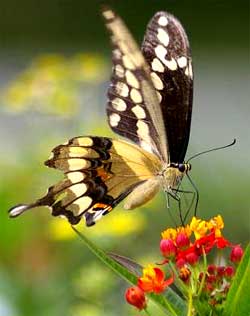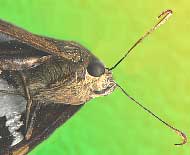


Robert M. Pyle's National Audubon Society Field Guide to North American Butterflies informs us that about 700 butterfly species occur in North America north of Mexico. The guide illustrates 600 of those, and has notes on 70 others.
Therefore, the number of butterfly species in North America north of Mexico is almost the same as the number of bird species, so, theoretically, butterfly watching should be approximately equivalent to bird watching. In reality, the difference in size between birds and butterflies, and the butterflies' less complex behavior (no songs or tail-wagging to help us identify them), makes butterfly watching more challenging than birding, and less exact.
In fact, Pyle says that distinguishing certain groups of look-alike butterflies, such as some checkerspots, green hairstreaks, and skippers, can confound even the experts. Certain species can only be determined by dissection. Therefore, with butterflies, sometimes identifying to genus level is the best we can do. In this matter, butterflying is different from birding, for birders generally believe that if they see any bird well enough and hear its song, they can figure out exactly which species it is.
 If you quietly sneak up to a butterfly on a flower, you
can watch it thrusting it long, slender, coiled proboscis into the flower to suck up sweet
nectar. You can see a typical butterfly proboscis at the top of our Insect Mouths Page. When you find a butterfly pupa, known as a
chrysalis (several shown on our Insect Pupae Page)
you can return to it each day and see how it's developing, and maybe even be lucky enough
to eventually see the adult butterfly emerging from its old pupa covering.
If you quietly sneak up to a butterfly on a flower, you
can watch it thrusting it long, slender, coiled proboscis into the flower to suck up sweet
nectar. You can see a typical butterfly proboscis at the top of our Insect Mouths Page. When you find a butterfly pupa, known as a
chrysalis (several shown on our Insect Pupae Page)
you can return to it each day and see how it's developing, and maybe even be lucky enough
to eventually see the adult butterfly emerging from its old pupa covering.
To really get the most from butterfly watching, however, you need to do more than just wander around looking. You need to organize your thoughts about butterflies. Mainly, you need to recognize that butterflies and their caterpillars and chrysalises are found in specific places, not just anywhere. Also, seeing a butterfly means a lot more to you if you know its name. Once you know its name you can talk about it, and look it up on the Internet to find out huge amounts of information about it. The way to look up a butterfly name is to do a search on the name using an Internet search engine.
Once you watch butterflies a while you'll realize that you're seeing the same common species again and again. This means that when you finally go to someplace special -- such as a park or nature preserve where there are unusual habitats -- you'll see completely new species! This will make your traveling a lot more fun.
Now let's look at some of the facts about butterflies that make butterfly watching more fun:
 When looking for butterflies we often need
to think in terms of specific plants. Whereas woodpeckers may be as content pecking on oak
trees as hickory, and sparrows as happy gobbling crabgrass seed as panic-grass seed, the Monarch caterpillar shown here feeds on milkweeds, the
Aphrodite caterpillar feeds on violets, and seldom on other plants. Juniper Hairstreak
caterpillars feed on junipers. Caterpillars of the Painted Lady shown at the right feed
mostly on members of the daisy family, particularly thistles.
When looking for butterflies we often need
to think in terms of specific plants. Whereas woodpeckers may be as content pecking on oak
trees as hickory, and sparrows as happy gobbling crabgrass seed as panic-grass seed, the Monarch caterpillar shown here feeds on milkweeds, the
Aphrodite caterpillar feeds on violets, and seldom on other plants. Juniper Hairstreak
caterpillars feed on junipers. Caterpillars of the Painted Lady shown at the right feed
mostly on members of the daisy family, particularly thistles.
On the other hand, as among birds, some butterfly species, such as Common Sulphurs, have evolved wonderful flexibility, and are found in many habitats.
The Audubon guide to butterflies includes a special Host Plant Index. Say, for example, that in or near your backyard there's a plum tree growing. The Host Plant Index leads you to pages recommending that around plum trees you should keep your eyes peeled for eggs and caterpillars of the Coral and Striped Hairstreaks, and the Viceroy.
Butterfly classification is a bit involved, with suborders, superfamilies, and the like. The following is a list of North America's most important butterfly families:
For more detailed information on how butterflies are related to one another, visit the Tree of Life website page dealing with the "superfamily" Papilionoidea, which embraces the "true butterflies," and thus not including the skippers.
Once you have some field experience you'll find yourself able to assign most butterflies you spot to their family, and this will help a lot when you use your butterfly-identification book. You'll spot something and, instead of thumbing through your entire field guide one picture at a time you'll go directly to the place in your field guide where members of that family are described.
 For instance, if you find the critter portrayed at the right you'll
immediately notice that it has clubbed antennae hooked
at their tips as well as a very
wide head on a body with rather short
wings. If you see it flying, you'll notice that it darts about jerkily. If you're familiar with your
major butterfly families you'll instantly know that this is one of the Common Skippers,
the Hesperiidae.
For instance, if you find the critter portrayed at the right you'll
immediately notice that it has clubbed antennae hooked
at their tips as well as a very
wide head on a body with rather short
wings. If you see it flying, you'll notice that it darts about jerkily. If you're familiar with your
major butterfly families you'll instantly know that this is one of the Common Skippers,
the Hesperiidae.
Your field guide will bring your attention to such items, and you can compare the butterfly you are seeing with pictures in the field guide.
Check out Butterflies of America (Alaska to Panama), Butterflies & Moths of North America, MonarchWatch.com and Chuck's Butterfly Page. The site The Butterfly Zone has lots of info.
You might be interested in Jim's experience identifying a certain hairstreak butterfly, when the butterfly's name recently had changed. Click here.
You might guess that much of butterfly identification focuses largely on wing colors and patterns. Of course, this is one of the charms of butterflying. Worse ways to spend one's time there are than determining whether the luminous yellow, orange, black, and powdery blue spots on a discovery's mostly black underwings more resemble licorice-edged Halloween candy-corn (the Eastern Black Swallowtail), or a brilliantly orange setting sun partially consumed in eclipse by the shadowed moon (Palamedes Swallowtail).
In short, there's little reason why butterfly watching can't be as exciting and as well organized an activity as bird watching or wildflower admiring. Butterfly watchers can compile life lists, meet monthly in clubs, and conduct field trips to good butterfly habitats. They can publish newsletters, sponsor speakers' bureaus for local schools, make butterfly-attracting plantings in their own gardens and backyards, and when good butterfly habitat is about to be replaced by yet another parking lot they can mobilize public opinion in support of other options!
All plants are complex soups of many kinds of chemical compounds, and often one or more of these compounds protect the plant by being poisonous to insects that would eat it. However, sometimes one or more insect species may have evolved that are tolerant to these poisons, and thus become the plant's main enemy.
Probably the most famous example of such a case is that of the Monarch Butterfly larvae's preference for eating milkweed leaves. Milkweeds contain powerful, poisonous alkaloids that repel many insects, but Monarch caterpillars thrive on them. Moreover, once the Monarch caterpillars metamorphose into adults, the adults retain some of the bitter alkaloids in their bodies so that they taste bitter to birds who eat them, so most experienced birds avoid eating Monarch butterflies.
In a similar vein, Black Swallowtail larvae are attracted to parsley, carrots, celery, and other plants in the Parsley Family containing the three chemical compounds known as anethole, anisic aldehyde, and methyl chavicol. It happens that the leaves of very unrelated orange trees also contain these chemicals, so Black Swallowtail larvae eat them as well.
You might enjoy reading through some of my fieldnotes dealing with butterflies and moths I've run across.